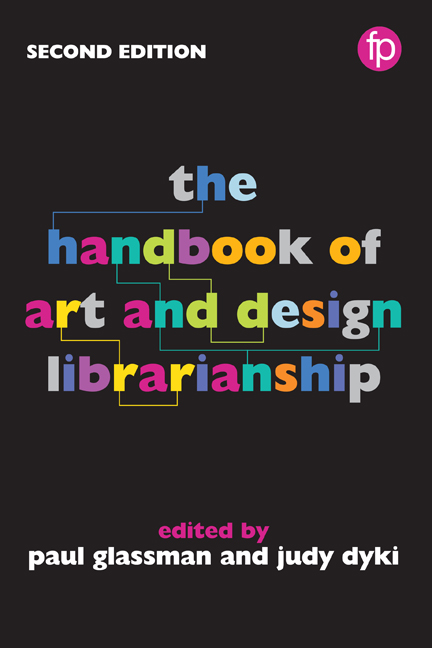Book contents
- Frontmatter
- Contents
- List of figures and tables
- Notes on contributors
- Foreword
- Preface
- Part I Roles and responsibilities
- Part II Materials and collection management
- Part III Teaching and learning
- Part IV Knowledge creation
- 21 The ever-shifting landscape: mapping the present and future of digital art histories
- 22 Critical cARTography: mapping spaces for dialogue about identity and artistic practices
- 23 More than just art on the walls: enhancing fine arts pedagogy in the academic library space
- 24 Beyond the monograph? Transformations in scholarly communication and their impact on art librarianship
- Part V The physical environment
- Part VI Promotion and sustainability
- Appendix Library profiles
- Index
23 - More than just art on the walls: enhancing fine arts pedagogy in the academic library space
from Part IV - Knowledge creation
Published online by Cambridge University Press: 08 June 2018
- Frontmatter
- Contents
- List of figures and tables
- Notes on contributors
- Foreword
- Preface
- Part I Roles and responsibilities
- Part II Materials and collection management
- Part III Teaching and learning
- Part IV Knowledge creation
- 21 The ever-shifting landscape: mapping the present and future of digital art histories
- 22 Critical cARTography: mapping spaces for dialogue about identity and artistic practices
- 23 More than just art on the walls: enhancing fine arts pedagogy in the academic library space
- 24 Beyond the monograph? Transformations in scholarly communication and their impact on art librarianship
- Part V The physical environment
- Part VI Promotion and sustainability
- Appendix Library profiles
- Index
Summary
Introduction
Much attention has been paid in the academy to creating active learning environments both within and outside the classroom. This focus on experiential and problem-based learning has become widely adopted or at least attempted by many in a relatively short period of time. While active learning in the fine arts has long been part of curricula (studio art, sculpture), little attention has been paid to creating a complete picture of the fine arts industry, specifically introducing the students to the juried selection, finishing and purchasing processes. Many times, collegiate artists leave their institutions with degrees but have never sold a piece of art nor know how even to approach this process.
Similarly, academic libraries’ spaces have become more collaborative in recent years, reflecting ever-changing curricula. However, with new technologies and collaboration areas, outreach and space design for scientific, social science and professional disciplines sometimes overshadow what the library could do for fine arts, specifically as exhibition space as well as curricular space.
This chapter outlines one initiative to include fine arts in the academic library space through a library-led and faculty-advised juried selection and purchasing process for fine arts students. The annual Student Art Purchase Award at Valparaiso University not only enhances fine arts students’ business acumen through experiential learning, but also increases the versatility of the library as multidisciplinary learning space.
Experiential learning as pedagogy
While art in the library is not a new concept, experiential learning in the form of independent undergraduate research is, comparatively. As a pedagogy, undergraduate experiential learning has gained much momentum in recent decades across the academy, but until recently has been largely absent from the library (Chandra, Stoecklin and Harmon, 1998; Kremer and Bringle, 1990; Russell, Hancock and McCullough, 2007).
Previously, librarians concentrated instruction efforts mostly on course-related research with little differentiation between undergraduate research and traditional curriculumbased research (Stamatoplos, 2009, 239). In fact, because these undergraduate researchers do not adhere to a traditional curriculum, ‘they can fail to recognise the potential value of interaction with librarians’ (Stamatoplos, 2009, 239). Even if librarians have started outreach to independent undergraduate researchers, little has been done to examine the library as an experiential learning space, particularly for fine arts pedagogy.
- Type
- Chapter
- Information
- The Handbook of Art and Design Librarianship , pp. 231 - 240Publisher: FacetPrint publication year: 2017
- 1
- Cited by



